Success stories: Tales of improving our native biodiversity
Mandy Tu/GIST
March 2002
Photographs
Click
on the images below to view photographs related
to this success story.
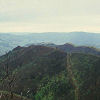
|
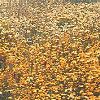
|
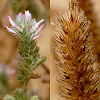
|
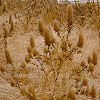
|
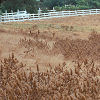
|

|
The Setting
The South Coast Ranges of California are typified by coastal-sage scrub and
southern oak forests along the coast, and by blue-oak (Quercus douglasii)
and foothill-pine (Pinus sabiniana) woodland and chaparral communities
in the hotter, inland slopes. Several sites within these mountain ranges,
especially those on serpentine outcrops, have high levels of native plant and
animal diversity. Most coastal-sage scrub and chaparral communities, however,
have recently been transformed by urbanization and suburban sprawl, and are no
longer suitable habitat for these species. Therefore, open landscapes with
high levels of native biodiversity in the South Coast Ranges of California are
rare and valuable.
The Invader - Restharrow (Ononis alopecuroides L.)
Restharrow is a highly-branched annual plant in the legume family (Fabaceae)
that is native to the western Mediterranean, northern Africa, and southern
Europe. Flowers of restharrow are pink, clustered in dense terminal spikes,
the leaves are trifoliate, and the upper stems of the plant are glandular and
hairy. In July 1998, a restharrow infestation was reported from San Luis
Obispo County, California (M. Lea, pers. comm.). Most plants in this
population were 2 to 3 ft (0.6 to 0.9 m) tall and had already completed their
annual growth cycle and produced seed.
This was the first documentation of restharrow in North America and was of concern because restharrow is considered an extremely invasive weed in northern Europe. In heavily infested areas there, restharrow forms dense colonies and outcompetes all native understory vegetation. It rapidly produces many seeds, making it difficult to eradicate once well-established. Restharrow is also undesirable in pastures and rangeland because it is completely unpalatable to horses and burros. The rich native biodiversity of California's South Coast Ranges was jeopardized by the presence of restharrow.
A Success Story
When restharrow was first noticed growing in an open grazed oak
woodland-savanna used for pasture, specimens were taken to an extension agent
in San Luis Obispo's Agricultural Commissioner's office. Unfamiliar with the
plant, they sent it to California's Department of Food and Agriculture's Botany
Lab Herbarium, where Senior Plant Systematist Dr. G. Fred Hrusa identified it
as Ononis alopecuroides.
When first discovered, the restharrow infestation was a single dense colony covering only 0.7 acre (0.28 ha). A few more plants were soon found in an adjacent orchard and along a dry drainage nearby. The infestation was spreading downslope towards nearby Suey Creek. If the plants had reached the creek, seeds would have been able to disperse downstream and the infestation might have quickly become uncontrollable. Since the infestation was still relatively small, the San Luis Obispo County Agricultural Commissioner's office committed to eradicate it, and control measures were rapidly implemented.
In the first year (1998), they pulled out every restharrow plant by hand. No restharrow plants have been allowed to set seed since then. In 1999, a few seedlings germinated but were immediately killed with herbicide. Outlier plants were hand-removed. In 2000 and 2001, more plants germinated from seed, and a different herbicide, which is more specific for control of legumes and a few other families of broad-leaved plants, was foliar applied with a backpack sprayer. Staff followed-up with numerous site visits, hand-removing any plants that persisted.
Marc Lea of the San Luis Obispo County Agricultural Commissioner's office reports that they are strongly committed to continuing this program until restharrow is eradicated from this site. Since the population was localized, eradication was not only possible but was in fact the most cost-efficient strategy. The longevity of seeds in the soil is unknown, however, so the county will survey this site every year for 10 years after the last new restharrow plants are found there.
More Information
For more information, contact Dr. Barry Rice, Associate Scientist of TNC's
Wildland Invasive Species Team at 530-754-8891 or at bamrice(at)ucdavis.edu. A
short summary article with more detailed information about restharrow,
including a description of its diagnostic characteristics, range, ecology, and
methods for its control, is available on The Nature Conservancy Wildland
Invasive Species Team's Invasives-on-the-Web
Ononis alert.
References
Hickman, J.C. 1993. The Jepson Manual: Higher Plants of California.
University of California Press, Berkeley.
Hrusa, G.F. 2000. Noteworthy collections: Ononis alopecuroides L.
Madrono 47(2): 139.
Hrusa, G.F. 2001. Senior plant systematist, Botany Laboratory Herbarium
(CDA), Plant Pest Diagnostics Branch, California Department of Food &
Agriculture, personal communication.
Lea, M. 2001. San Luis Obispo County Agricultural Commissioners Office,
personal communication.
Little, R. 2001. San Luis Obispo County Agricultural Commissioners Office,
personal communication.
Morisawa, T. 2000. Weed Alert: Ononis alopecuroides. The Nature
Conservancy's Wildland Invasive Species Program
(http://tncinvasives.ucdavis.edu/alert/alrtonon.html).
This document in other formats: MS Word, Adobe Acrobat
This article may be treated as a press release and may be quoted by the media in part or in full. Publication quality versions of images on this page can be obtained from the Wildland Invasive Species Team by sending email to bamrice(at)ucdavis.edu.


